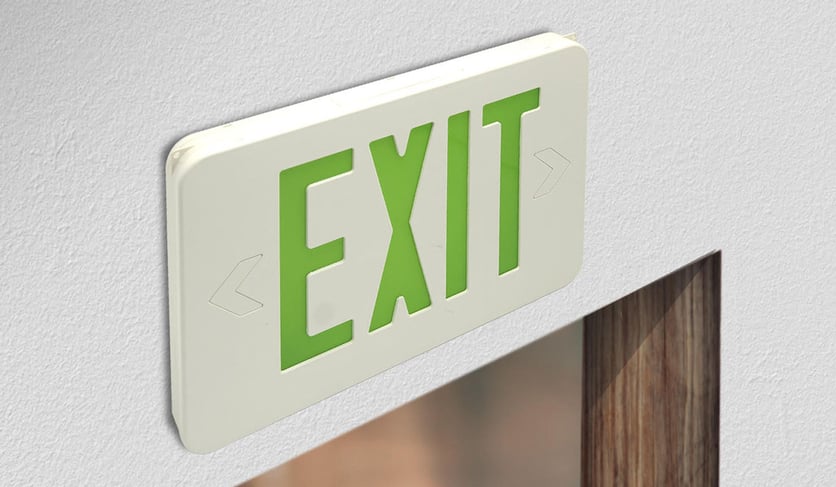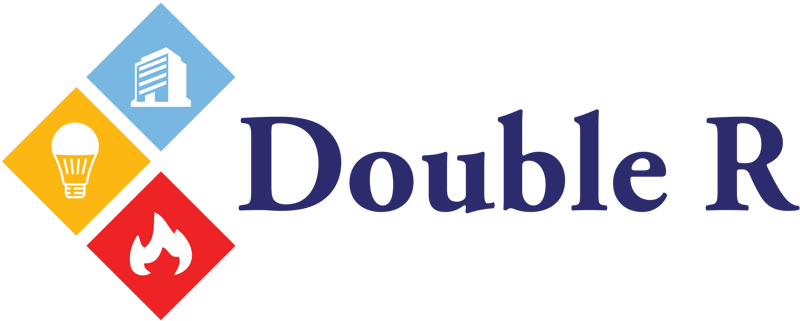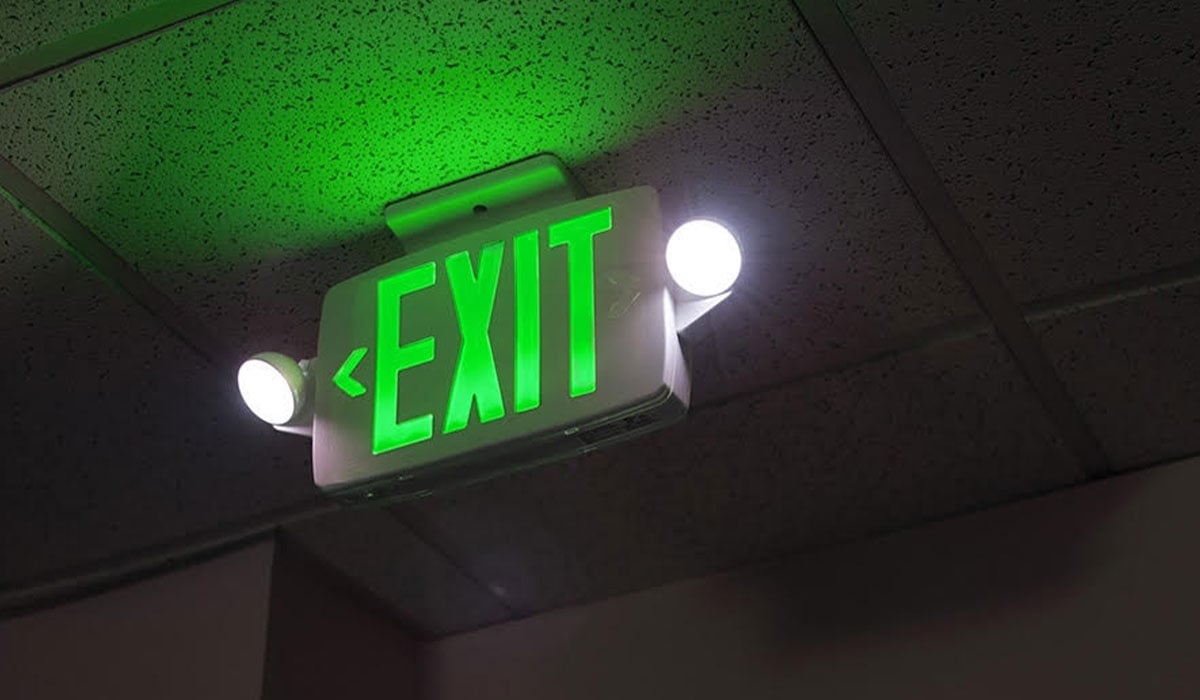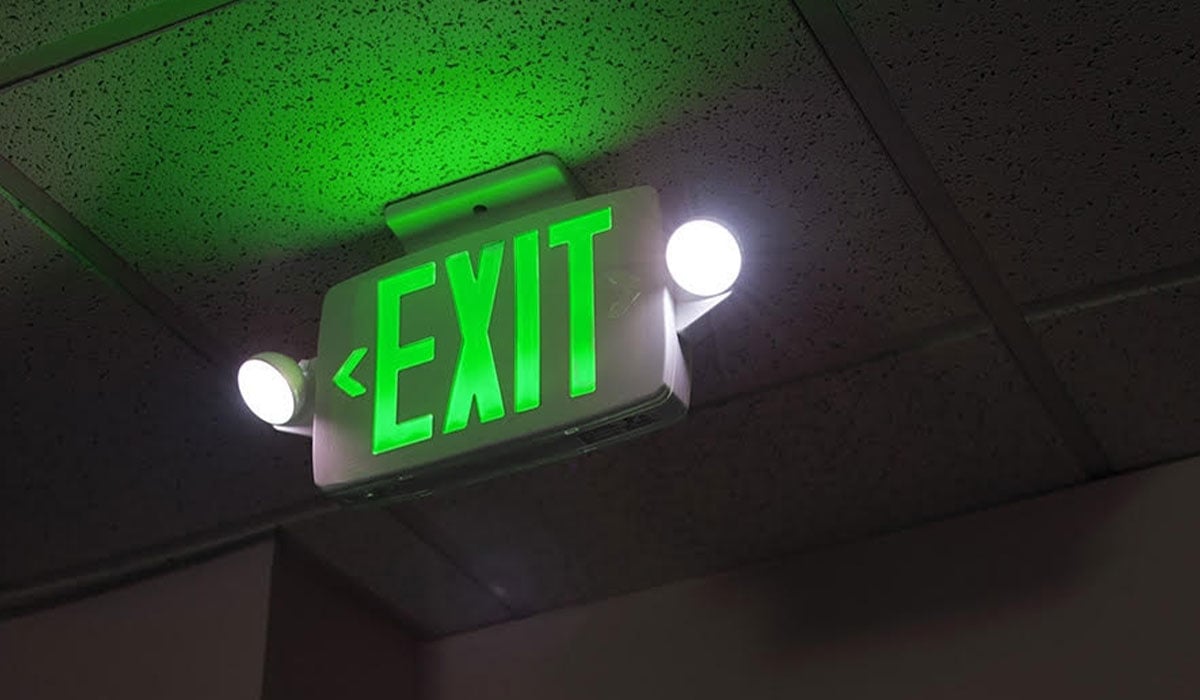Emergency exit lighting and signage are among the most important safety features of any business.
In the event of fire, smoke, power outage, or other dangerous situations, emergency exit lighting illuminates safe evacuation routes when other systems are not functioning.
While fire alarms alert occupants and sprinkler systems extinguish flames, lighting systems are crucial in guiding people outside to safety.
To ensure commercial properties are up to code, compliant with state and township requirements, and these systems function, it is important property managers ensure their proper installation, inspection, and maintenance.
To help, here are several important considerations and insights from the experienced technicians at Double R Security regarding these critical, life-saving systems.
Commercial Emergency Exit Lighting Requirements
To protect building occupants from the dangers of fire, smoke, and toxic fumes, all commercial properties are required to follow Occupational Safety and Health Administration (OSHA) code.
Created by the National Fire Protection Association (NFPA), these NFPA 101 Life Safety Code regulations set the minimum standards for building design, construction, maintenance, and operations.
While comprehensive, there are a few key emergency exit lighting protocols all businesses must follow:
- Exit Sign Above Every Exit: Commercial buildings must place exit signs above every exit to guide staff to safety in case of emergencies. Whether during instances of smoke or power outages, signs must be illuminated so employees can locate safe exit paths and evacuate the building.
- Means of Egress: Doors, ramps, stairs, and other pathways should be made visible by operational emergency lighting so people can easily find safe exits.
- Fire Evacuation Paths: Workplaces must have at least two evacuation routes available for staff to follow during emergencies, with exit signs denoting safe routes.
Emergency Exit Lighting Installation
To be compliant with these requirements, all emergency exit lighting must be properly installed and remain operational.
It is important to ensure safety procedures are followed during an installation, and it is best practice to consult an experienced technician for help or to install the unit for you.
During installation, consider the following protocols for wall- and ceiling-mounted emergency exit lighting:
Before You Start: Although emergency lighting is connected to a building’s electrical wiring, it will switch to battery power if disconnected during a fire or outage. To prevent electrocution during installation, ensure you turn off the house circuit you’re connecting the unit to, and that your fuse box safety tag reads “Do Not Energize.”
Mounting Options: There are two main mounting options you might consider when installing emergency exit lighting: wall or ceiling.
Here is how to mount units in both locations:
How to Install Ceiling Lighting
- Remove the wire pass cutouts from either the sides or top of your unit.
- Screw the canopy to the power pack or lighting sign.
- Using the two longest screws on either side of the hanging plate’s outer holes, attach the unit to the plate.
- Thread the wiring through the center hole and attach the plate to the electrical box.
- Thread the circuit wiring through the pass hole, and then to the power pack.
- Ensure the long screws pass through the plate’s holes, and place the canopy or sign onto the electrical box.
- Secure the sign or canopy using nuts.
- Once mounted, cover the wiring with metal or thermoplastic housing units.
 How to Install Wall Lighting
How to Install Wall Lighting
- Remove the mounting pattern cutouts from the back plate and thread through the wires.
- Install the bushing tubes into the wire holes, which enable electricity to pass through without making contact with the unit.
- Thread the circuit wiring through the pass hole and connect it to the sign.
Emergency Exit Lighting Inspections, Maintenance & Service
To ensure your emergency exit lighting systems are running properly when you need them most, preventative maintenance is key for any business.
Aside from being a regulatory requirement with violations punishable by fines, these crucial systems help building occupants find exit routes and safely evacuate in the event of fire, smoke, power outages, and other emergencies.
It’s of utmost importance they therefore function optimally all the time—achievable through consultations with experienced technicians specializing in preventative inspections, maintenance, and service.
“I would like to get out of this, ‘Okay, this company tests and inspects our exit emergency signs and lighting and there's a problem,’ and into, ‘We'll know that they work,’” explains Derek Splendorio, Vice President of Double R Security.
“In case of emergency, if the exits are not lit, people can be trapped within a space,” he continues. “If the means of egress are not lit, people can get lost and delay their exits, and things can happen.”
To avoid violations and fines, and most importantly, prioritize the safety of employees and customers, property managers should seek trusted industry professionals for robust inspections, maintenance, and proactive service.
Depending on your city or state, your commercial systems should be inspected monthly, quarterly, biannually, or annually.
New Jersey is required to perform monthly preventative maintenance, auditing the following:
- Ensure Designated Emergency Lighting
- Inspect Housing for Physical Damage
- Conduct a 30-Second Push Test
- Verify Lamps Are Illuminated & Aimed in Correct Direction
- Maintain Monthly Inspection Logs by the Authority Having Jurisdiction (AHJ)
To ensure your business is keeping up with required maintenance at appropriate intervals, Double R provides robust inspection services on a pre-scheduled monthly, quarterly, biannual, or annual basis. This way, you can manage your property knowing every facet of your emergency exit lighting is functioning optimally, at all times.
The Double R team covers the following areas and actions during emergency lighting inspections:
- Lighting Systems: an inspection to ensure proper operations in accordance with NFPA standards
- System Illumination Tests: to verify illumination for at least 90 minutes (as mandated by OSHA, NFPA, and National Electric Code (NEC) standards)
- Bulbs & Lamps: an inspection of all bulbs and lamp heads to confirm they are operational and meet lighting requirements
- Lights & Signs: to certify proper placements
- Energy Efficiency Audits: to determine the maximum cost-effectiveness and proficiencies of bulbs and lamps—with LEDs providing the most consistent, hazardous, non-interrupted operations
- Tag Devices & Provide Recordkeeping: to verify devices are properly tagged and labeled, and all mandated recordkeeping adheres to proper protocols. While not a requirement, Double R provides log books with locations of each individual device.
- Site Conditions Compromising System Performance: to identify detrimental site conditions that could compromise the performance of mechanical and/or electronic components of the system. These most commonly include blockages (such as shelving or inventory obstructing emergency exit lighting), forklifts in warehouses (which can knock down and destroy lighting units), and even balloons throughout stores (which can cover some devices), explains Splendorio.
- Inspection Reports: to compile a complete report of the inspection, explaining any deficiencies and recommending corrective action in accordance with recognized codes for care and maintenance
Why Double R?
Relying on experienced technicians to ensure all your systems function optimally at all times grants invaluable peace of mind, and improves efficiencies.
Our trusted team of experts has more than 30 years of industry experience in the medical, industrial, surgical, retail, dental, and commercial industries, throughout the Northeast.
Fully licensed, National Institute for Certification in Engineering Technologies (NICET)-certified, and holding a New York City Fire Department (FDNY)-approved Certificate of Fitness, among others, we will ensure your systems remain operational and compliant in emergencies.
From reliable installation to comprehensive inspections, our one-stop shop’s number one priority is your safety, at all times.
Double R is an industry leader in the installation, inspection, and servicing of emergency exit lighting, carbon monoxide detectors, CCTVs, generators, and more. To ensure your systems are compliant and functioning optimally, contact our experienced team today.



